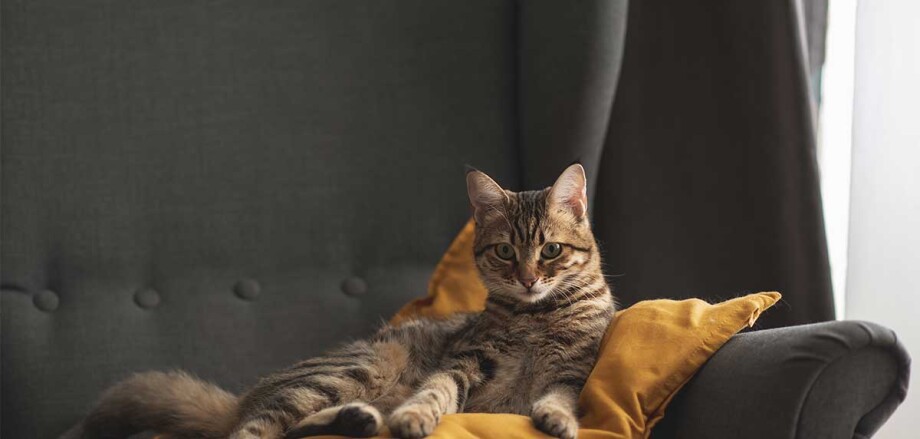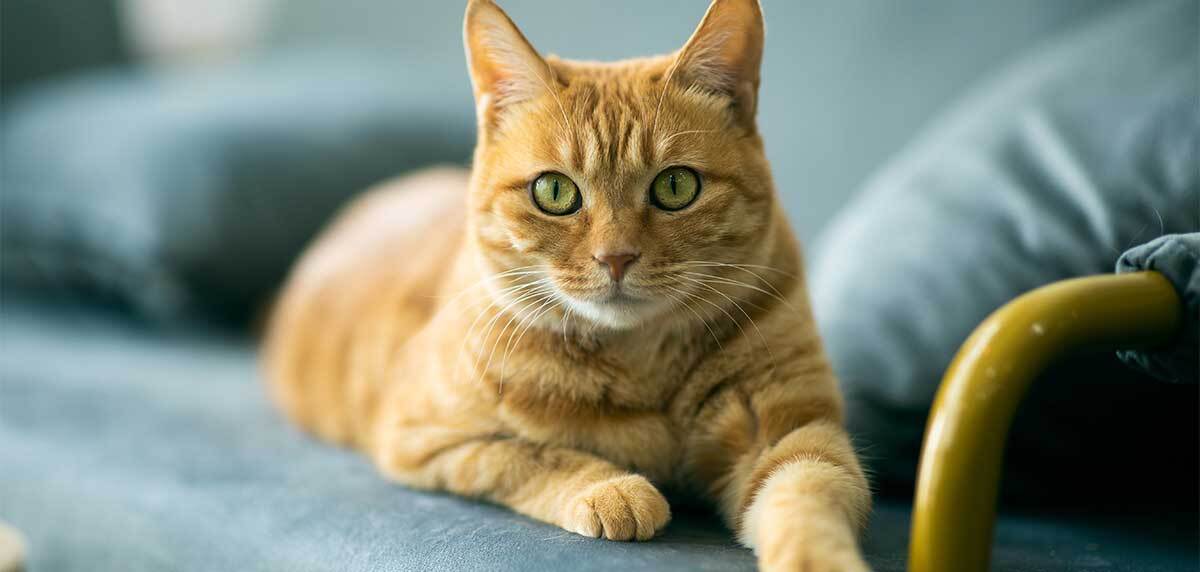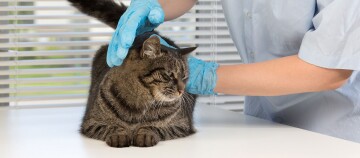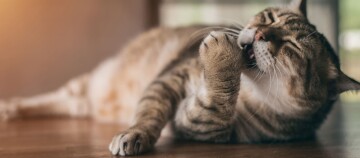Vomiting cat – the possible causes and treatment
22.12.2023 - Reading time: 8 minutes

If your cat is vomiting, you are naturally worried. Find out here what the causes could be.
Vomiting in cats is a symptom that generally shows that your little feline has a digestive problem. It is often accompanied by abdominal cramps that allow the cat to quickly get rid of the contents of its stomach. The severity of vomiting depends on what the cat is vomiting and how often. If in doubt, it is always best to consult a vet.
Why is my cat vomiting?
Has your cat vomited their biscuits after their meal or vomited a white foam? You are probably wondering if this is dangerous and what caused it. The reasons are very varied and can be harmless or serious. Here are just a few examples:
- Your little guzzler has eaten their biscuits too quickly
- A food intolerance or allergy
- A change in diet that took place too quickly
- Ingestion of a foreign body
- Poisoning, for example from plants
- A gastrointestinal infection
- An inflammatory bowel disease
- Constipation with the presence of a faecal impaction
- Stress
- Travel sickness
This list is not exhaustive and for a cat that vomits often, it may also be a symptom of a non-digestive illness.
Cat that vomits its biscuits
Your cat has just eaten and a little while later, they vomit their biscuits onto the carpet. What you think is vomit may actually be regurgitation. You can tell by looking at exactly what your feline companion has spat out. Regurgitated food has not reached the stomach and is not digested. It looks like mashed biscuits and is not as nauseating as vomit. Were you there when your cat “vomited”? Regurgitation is not accompanied by abdominal cramps so it’s quite easy to tell the difference The more accurately you observe the symptoms, the better your vet will be able to help you and make a diagnosis. You may be asking “Why is my cat vomiting their non-digested food”? Some cats, like the famous cartoon character Garfield, love to eat and pounce on their bowl full of succulent biscuits straight away. If your cat eats their food too quickly, the risk of regurgitation is higher. To avoid this, give your little furball smaller quantities of food several times a day. Buying a slow feeder bowl is definitely a good idea. An interactive bowl with an opening and a reserve compartment so that your cat can grab its food with its paw is also a good idea. This means they only get a small amount each time and have to eat more slowly. The fact that your cat behaves more like a greedy guts than a food lover may be down to the quality of the food you offer. If it does not meet their nutritional needs, they will have to eat more to make up the shortfall. Premium food suitable for the age of your cat may solve this problem.
My cat’s vomit is yellow – Is this serious?
When a cat vomits a yellow liquid, it is bile. As in humans, bilious vomit comes from an empty stomach. There are various reasons for a cat vomiting bile:
- Your little feline’s meals are too far apart; cats need to eat regularly several times a day. Self-service biscuits are a good solution.
- Liver disorders, such as hepatitis or liver tumours.
- Hairballs: when cats with long fur like the Persian lick
themselves, they swallow dead hairs which then form small clumps and are vomited up. In this instance, you will find hairs in the bile.
Serious illnesses such as digestive cancers can also lead to bile vomiting. If the vomiting happens frequently, seek advice from your vet. They will identify any illness and prescribe the appropriate treatment.

My cat is vomiting white foam
The most common causes of vomiting white foam in cats are the following:
- Foreign bodies, such as hairballs that accumulate in the stomach
- Acute or chronic gastritis
- Inflammation of the pancreas, also called pancreatitis
- Intestinal parasites
- Liver failure
- Inflammatory bowel disease
Other symptoms usually accompany vomiting of white foam, helping the owner and vet to identify the cause. So keep a close eye on your little feline so you can give the vet as much information as possible. Make a note of the answers to the following questions:
- Does my cat have diarrhoea?
- Is my cat constipated?
- Does my cat seem tired, even lethargic?
- Has my cat lost weight recently?
- Is my cat’s coat dull?
- Does my cat have bad breath?
- Does my cat’s urine have a sweet odour?
- Is my cat lacking appetite?
Don’t forget to always provide your vomiting cat with plenty of water. Otherwise, there is a risk of dehydration.
My cat is vomiting a transparent liquid
Have you noticed that your cute four-legged friend sometimes vomits a transparent liquid? One very simple and harmless reason may be that your cat drank too much water too quickly. This is rare as cats usually drink small quantities each time. However, some conditions like diabetes can make cats drink more. Another reason why a cat may drink too much is a diet without wet food. Alternating biscuits and wet cat food helps your little friend to stay hydrated without having to drink too much. When it is very hot, you should always leave water out for your adorable feline. If they stay in the sun for a long time without having access to water, they may drink too much at once when you fill their bowl. A water fountain is a good alternative. This will provide your cat with unlimited fresh water.
Cat vomit – When to worry?
If your cat has vomited once but seems to be well, it’s probably nothing serious. Keep an eye on them for a day or so to see if they vomit again and if any other symptoms appear. This recommendation does not apply in the case of a cat vomiting blood. Even one case of vomiting blood should be taken seriously. The presence of blood in vomit indicates internal bleeding. If the blood is bright red, it is coming from the stomach or oesophagus. If it is dark red, it has been digested and comes from the lower part of the small intestine. Although the presence of blood in a cat’s vomit worries owners, it is not necessarily serious. When a cat vomits often, this irritates the walls of the digestive tract and may lead to slight bleeding. Ingestion of a foreign body can lead to perforation of the digestive tract and bloody vomiting. Other causes are: a gastric ulcer, inflammation of the oesophagus, a viral or bacterial infection, ingestion of a toxic substance and an accident. Whatever the cause, if you cat vomits blood, do not waste time and call your vet. You will certainly need to get there quickly to avoid any serious complications.
How do you make a cat vomit?
Your cat has ingested a toxic substance or an object and your first reaction is to make them vomit in order to get rid of it. Warning! Making your cat vomit could make the situation worse. The best thing to do is to call your closest vet immediately. They will ask you questions and tell you what to do. In most cases, you should visit the surgery as a matter of urgency. You should never make your cat vomit yourself in the following cases:
- They have already vomited and you think they have been poisoned
- You don’t exactly know what they swallowed
- They ingested a toxic substance over two hours ago
- They suffer from heart or neurological problems
- They have ingested a corrosive substance or hydrocarbons
- They are unconscious
- They have swallowed a sharp object, thread or ribbon
By trying to do the right thing, you could make the situation worse and put your little furball’s life in danger. Self-medication is therefore strongly discouraged. In an emergency, you can go to the veterinary clinic immediately, after checking by telephone that it is open. Try to stay calm so you do not add to your cat’s stress. Speak to them with a soft voice and tell them, for example, that you are taking care of them and are going to take them to the vet who will know what to do. If caught in time, ingesting a toxic substance or object will be nothing but a bad memory for you and your faithful feline companion.



